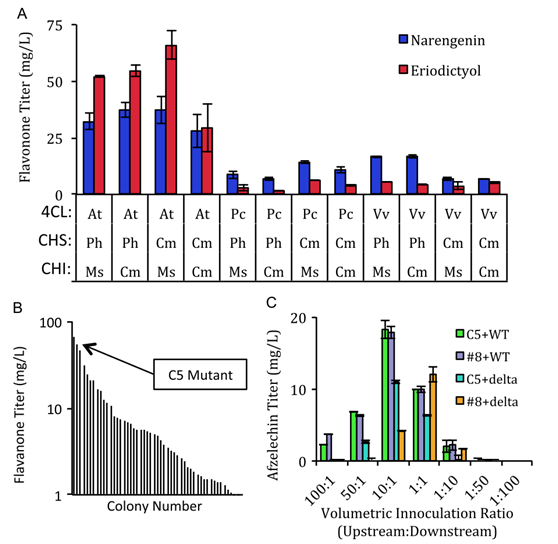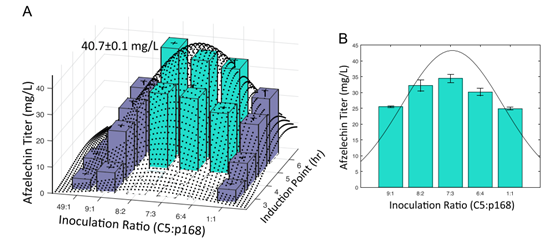博文
2016 Metabolic Engineering:高效生产黄酮类化合物的大肠杆菌共培养实验与计算优化
|
2016 Metabolic Engineering:Experimental and computational optimization of an Escherichia coli co-culture for the efficient production of flavonoids
2016 Metabolic Engineering:高效生产黄酮类化合物的大肠杆菌共培养实验与计算优化
集锦
•从苯丙酸获得的阿夫儿茶精滴度为40.7±0.1 mg/L。
•经验计算模型指导的优化结果使滴度增加65%。
•证明滴度比以前的单一培养提高了970倍。
摘要:
代谢工程和合成生物学使微生物生产平台得以用于许多高价值天然产品的可再生生产。然而,滴度和产量通常太低,无法产生商业上可行的工艺。微生物共培养能够分配代谢负荷,并允许模块化特定优化,这是传统单一培养发酵方法不可能做到的。在这里,我们提出了一种利用大肠杆菌共培养高效生产类黄酮,黄烷-3-醇类的滴度比利用单一培养报道的提高了970倍。为提高滴度,对菌株相容性、碳源、温度、诱导点、接种比等因素进行了初步优化。然后基于初始优化数据建立经验尺度高斯模型,预测系统的最优点。模型预测的实验验证结果表明,与先前的最佳值相比,黄烷-3-醇类的滴度价提高了65%,达到40.77±0.1 mg/L。总的来说,本研究展示了黄酮类化合物共培养生产的首次应用,迄今为止最深入的共培养优化,以及首次应用经验系统模型从共培养系统提高滴度。

图1。类黄酮途径上游(绿色)丙二酰辅酶A依赖和下游(蓝色)NADPH依赖共培养模块。(为了解释本图图例中对颜色的引用,请参考本文的web版本。)
Fig. 1. Flavonoid pathway highlighting upstream (green) malonyl-CoA dependent and downstream (blue) NADPH dependent co-culture modules. (For interpretation of the references to color in this figure legend, the reader is referred to the web version of this article.)

图2 上游菌株优化及共培养亲和性测定。(A)对12个潜在的上游同源组合的筛选产生了一些高滴度的途径。(B)e途径优化技术在转录优化中的应用导致了对转录环境变化的高度敏感性。(C) 在附加发酵优化之前,从单个菌株优化研究中获得的菌株在共培养中生长以确定菌株的相容性。所有数据均在AMM–2%葡萄糖,30℃诱导温度下获得。误差条代表7重复实验的一个标准偏差。
Fig. 2. Upstream strain optimization and co-culture compatibility determination. (A) Screening of 12 potential upstream homolog combinations resulted in several high-titer pathways. (B) Application of e Path Optimize technique for transcriptional optimization resulted in high sensitivity to changes in the transcriptional landscape. (C) Lead strains from the individual strain optimization studies were grown in co-culture to determine strain compatibility prior to additional fermentation optimization. All data was obtained in AMM – 2% glucose, 30 °C induction temperature. Error bar represent7one standard deviation from duplicate experiments.

图5 共培养系统的实验点与模型预测。柱表示实验数据点,而曲面图(黑色)表示模型预测的生产情况。紫色柱表示模型培训集中包含的数据,而绿色柱表示为模型验证选择的点。数据在30℃的诱导温度下在20 g/L甘油介质中测量。(A) 模型预测与实验确定的生产环境的三维对比。(B)在模型预测的最佳诱导点,5.67h时,将实验数据与模型进行比较。误差线代表7个重复或更大(nZ2)实验的标准偏差。(为了解释本图图例中对颜色的引用,请参考本文的web版本。)
Fig. 5. Experimental points vs. model predictions for the co-culture system. Columns represent experimental data points, while the surface plot (black) represents the model-predicted production landscape. Purple columns represent data included in the model training set, while green columns represent the points selected for modelvalidation. Data were measured at an induction temperature of 30 °C in 20 g/L glycerol media. (A) 3D comparison of model predicted vs. experimentally determinedproduction landscape. (B) Comparison of experimental data to model at model predicted optimum induction point, 5.67 h. Error bars represent7one standard deviationfrom duplicate or greater (nZ2) experiments. (For interpretation of the references to color in this figure legend, the reader is referred to the web version of this article.)
https://blog.sciencenet.cn/blog-2675068-1224618.html
上一篇:2016 PPB: 真菌内生真菌胶皮糖香拟茎点霉和慢生根瘤菌联合接种增强花生的结瘤作用
下一篇:2012 Nature Reviews Microbiology:微生物相互作用:从网络到模型